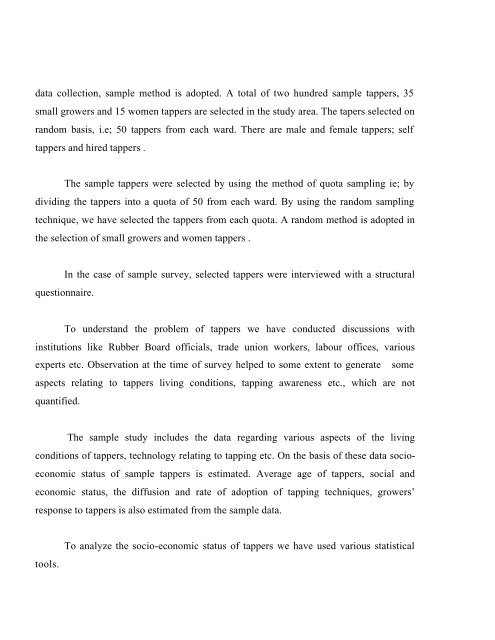socio-economic profile of rubber tappers in the small holding sector
socio-economic profile of rubber tappers in the small holding sector
socio-economic profile of rubber tappers in the small holding sector
You also want an ePaper? Increase the reach of your titles
YUMPU automatically turns print PDFs into web optimized ePapers that Google loves.
data collection, sample method is adopted. A total <strong>of</strong> two hundred sample <strong>tappers</strong>, 35<br />
<strong>small</strong> growers and 15 women <strong>tappers</strong> are selected <strong>in</strong> <strong>the</strong> study area. The tapers selected on<br />
random basis, i.e; 50 <strong>tappers</strong> from each ward. There are male and female <strong>tappers</strong>; self<br />
<strong>tappers</strong> and hired <strong>tappers</strong> .<br />
The sample <strong>tappers</strong> were selected by us<strong>in</strong>g <strong>the</strong> method <strong>of</strong> quota sampl<strong>in</strong>g ie; by<br />
divid<strong>in</strong>g <strong>the</strong> <strong>tappers</strong> <strong>in</strong>to a quota <strong>of</strong> 50 from each ward. By us<strong>in</strong>g <strong>the</strong> random sampl<strong>in</strong>g<br />
technique, we have selected <strong>the</strong> <strong>tappers</strong> from each quota. A random method is adopted <strong>in</strong><br />
<strong>the</strong> selection <strong>of</strong> <strong>small</strong> growers and women <strong>tappers</strong> .<br />
In <strong>the</strong> case <strong>of</strong> sample survey, selected <strong>tappers</strong> were <strong>in</strong>terviewed with a structural<br />
questionnaire.<br />
To understand <strong>the</strong> problem <strong>of</strong> <strong>tappers</strong> we have conducted discussions with<br />
<strong>in</strong>stitutions like Rubber Board <strong>of</strong>ficials, trade union workers, labour <strong>of</strong>fices, various<br />
experts etc. Observation at <strong>the</strong> time <strong>of</strong> survey helped to some extent to generate some<br />
aspects relat<strong>in</strong>g to <strong>tappers</strong> liv<strong>in</strong>g conditions, tapp<strong>in</strong>g awareness etc., which are not<br />
quantified.<br />
The sample study <strong>in</strong>cludes <strong>the</strong> data regard<strong>in</strong>g various aspects <strong>of</strong> <strong>the</strong> liv<strong>in</strong>g<br />
conditions <strong>of</strong> <strong>tappers</strong>, technology relat<strong>in</strong>g to tapp<strong>in</strong>g etc. On <strong>the</strong> basis <strong>of</strong> <strong>the</strong>se data <strong>socio</strong>-<br />
<strong>economic</strong> status <strong>of</strong> sample <strong>tappers</strong> is estimated. Average age <strong>of</strong> <strong>tappers</strong>, social and<br />
<strong>economic</strong> status, <strong>the</strong> diffusion and rate <strong>of</strong> adoption <strong>of</strong> tapp<strong>in</strong>g techniques, growers’<br />
response to <strong>tappers</strong> is also estimated from <strong>the</strong> sample data.<br />
tools.<br />
To analyze <strong>the</strong> <strong>socio</strong>-<strong>economic</strong> status <strong>of</strong> <strong>tappers</strong> we have used various statistical










